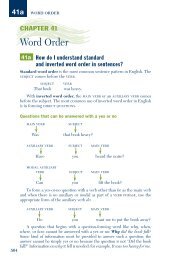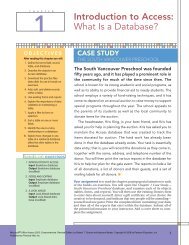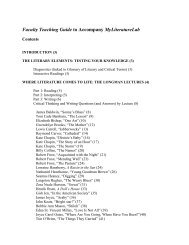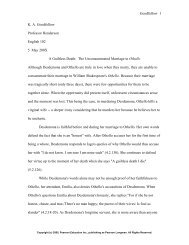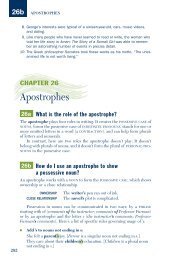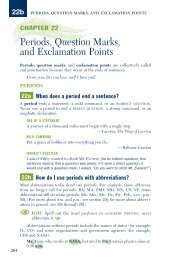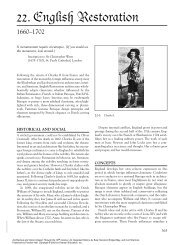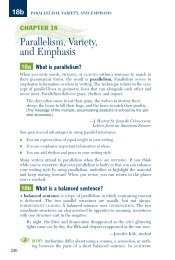JavaScript/JScript: Control Structures I - Pearson Learning Solutions
JavaScript/JScript: Control Structures I - Pearson Learning Solutions
JavaScript/JScript: Control Structures I - Pearson Learning Solutions
You also want an ePaper? Increase the reach of your titles
YUMPU automatically turns print PDFs into web optimized ePapers that Google loves.
2008934301<br />
Chapter 14 <strong>JavaScript</strong>/<strong>JScript</strong>: <strong>Control</strong> <strong>Structures</strong> I 405<br />
prints Passed if the student’s grade is greater than or equal to 60 and prints Failed if the<br />
student’s grade is less than 60. In either case, after printing occurs, the next pseudocode<br />
statement in sequence (the next statement after the whole if/else structure) is “performed.”<br />
Note that the body of the else is also indented.<br />
Good Programming Practice 14.2<br />
Indent both body statements of an if/else structure. 14.2<br />
The indentation convention you choose should be carefully applied throughout your<br />
programs (both in pseudocode and in <strong>JavaScript</strong>). It is difficult to read programs that do not<br />
use uniform spacing conventions.<br />
The preceding pseudocode if/else structure may be written in <strong>JavaScript</strong> as<br />
if ( studentGrade >= 60 )<br />
document.writeln( "Passed" );<br />
else<br />
document.writeln( "Failed" );<br />
The flowchart of Fig. 14.4 nicely illustrates the flow of control in the if/else structure.<br />
Once again, note that the only symbols in the flowchart (besides small circles and<br />
arrows) are rectangles (for actions) and a diamond (for a decision). We continue to emphasize<br />
this action/decision model of computing. Imagine again a deep bin containing as many<br />
empty double-selection structures as might be needed to build a <strong>JavaScript</strong> algorithm. The<br />
programmer’s job is to assemble the selection structures (by stacking and nesting) with<br />
other control structures required by the algorithm and to fill in the empty rectangles and<br />
empty diamonds with actions and decisions appropriate to the algorithm being implemented.<br />
<strong>JavaScript</strong> provides an operator called the conditional operator (?:) that is closely<br />
related to the if/else structure. The operator ?: is <strong>JavaScript</strong>’s only ternary operator—<br />
it takes three operands. The operands together with the ?: form a conditional expression.<br />
The first operand is a boolean expression, the second is the value for the conditional expression<br />
if the condition evaluates to true and the third is the value for the conditional expression<br />
if the condition evaluates to false. For example, the statement<br />
print “Failed”<br />
false<br />
grade >= 60<br />
true<br />
Fig. 14.4 Flowcharting the double-selection if/else structure.<br />
print “Passed”<br />
e-Business and e-Commerce: How to Program, by Harvey M. Deitel, Paul J. Deitel, and Tem R. Nieto. Published by Prentice Hall.<br />
Copyright © 2001 by <strong>Pearson</strong> Education, Inc.




